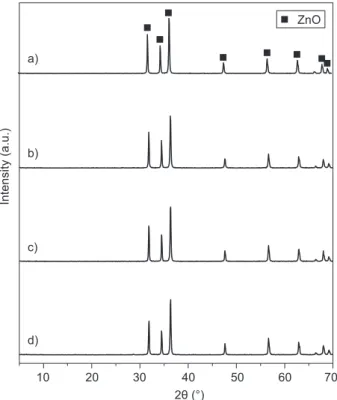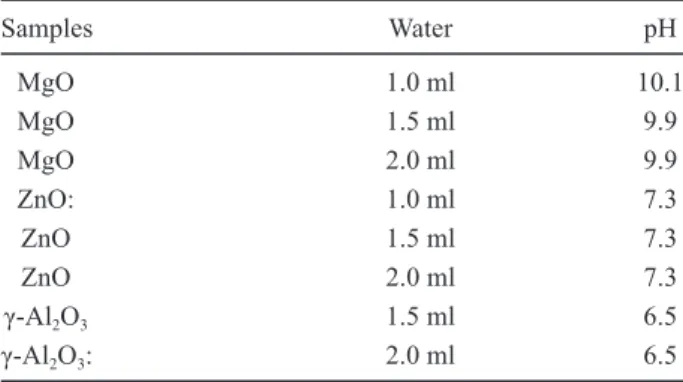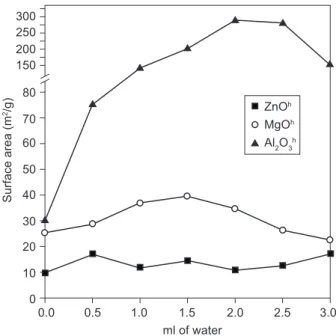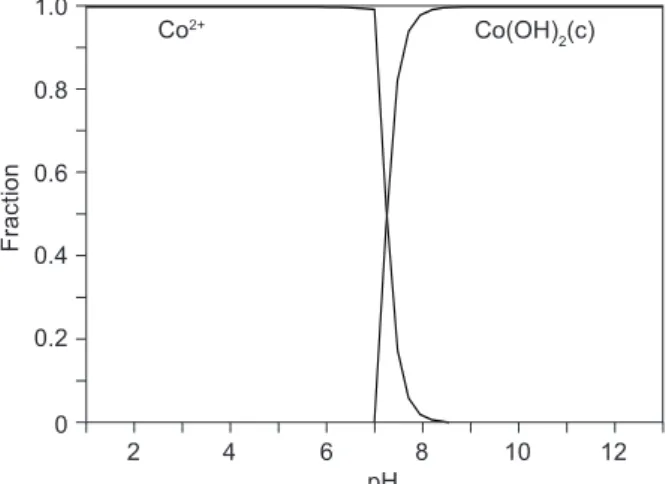SYNTHESIS OF MgO, ZnO AND Al
2O
3BY SOLID AND SOLUTION
COMBUSTION PROCESSES AND STUDY
OF THEIR PERFORMANCES IN Co
2+UPTAKE
J. E. MORENO-MARCELINO*, #F. GRANADOS-CORREA**, H. PFEIFFER**, S. BULBULIAN***
*Instituto Nacional de Investigaciones Nucleares, A.P. 18-1027, Col. Escandón, Delegación Miguel Hidalgo, 11801 México D.F., México
**Instituto de Investigaciones en Materiales, Universidad Nacional Autónoma de México, circuito exterior s/n, Cd. Universitaria, Del. Coyoacan, CP 04510, México D.F, México
***CCADET, Universidad Nacional Autónoma de México,
circuito exterior s/n, Cd. Universitaria, Del. Coyoacan, CP 04510, México D.F, México
#E-mail: francisco.granados@inin.gob.mx Submitted January 6, 2012; accepted September 3, 2012
Keywords: Metallic oxides, Solid-combustion process, X-ray diffraction, Surface properties, Co2+ uptake
The study discusses the effect of magnesium, zinc and aluminum oxides prepared by the solid and solution-combustion process. The powders were synthesized by using different urea to metal nitrates ratio and different water concentrations in the solutions. They were characterized by X-ray diffraction, BET surface area and their performance in Co2+ uptake from
aqueous solutions was studied. Results showed that water addition up to a certain limit during the solution combustion method modiied the textural properties of the different oxides and that powders obtained by this process have interesting properties, increase the capacity to uptake Co2+ present in water, and increase the surface area of the materials. It was also
found that further increments of water in the solutions decreased the Co2+ uptake capacity of the obtained solids. Results with
Co2+ ions indicate that they are readily related to the solids prepared by solution combustion processes. It was found that that
solution combustion favors cobalt uptake, depending on the amount of water used in the solution.
INTRODUCTION
Combustion synthesis is a very rapid chemical process based on the principle of explosive decomposition of urea that takes less than 5 minutes to arrive at completion. It involves the exothermic reaction of an organic fuel, in this case, urea, in the furnace chamber, producing metal oxides through the reduction process of metal nitrates [1, 2]. As a result, metal oxides products and gas emission of CO2, H2O and nitrogen oxides (NO2) can be formed directly from the reaction between metal nitrates and urea without the need to get oxygen from outside.
In a previous work [3], solution combustion effects on the combustion preparation of MgO were presented. The obtained materials were characterized through their speciic area, morphology, fractal dimension and Co2+ adsorption. A liner correlation between the fractal dimension and Co2+ adsorption was found.
Cobalt immobilization can occur through retention on several oxides. Several methods have been reported to be effective in generating very ine powders of ceramics that can be used for Co2+ uptake from water solutions. During past decades, a variety of contaminants in water has been developed for use as adsorbents [4, 5].
The selection of a speciic solid to retain metal ions depends mainly on its capacity and selectivity for the
species to be removed from a particular metal ion. Some retention processes are very dependent on the surface charge of these materials, on the form of the chemical species at various pH values, or on the speciic surface areas of the solids [6, 7]. However, a clear understanding of all relevant species present in a given solution is of primary interest, because it is widely recognized that the speciation of metal ions can profoundly affect their separation behavior.
The aim of this paper is to explore the use of solid and solution-combustion derived metal oxides, MgO, ZnO and Al2O3, and study of their performances in Co2+ uptake from aqueous solutions. In particular, the objective is to obtain a better understanding of these two processes, showing whether the solution combustion favors Co2+ uptake, depending on the amount of water used in the solution during the synthesis process.
EXPERIMENTAL Materials
98 wt. % purity, and NH2CONH2 A.C.S. reagent 99-100 wt. % purity were purchased from Sigma Aldrich. Co(NO3)2·6H2O A.C.S. reagent 100 wt. % purity was purchased from Baker.
Synthesis by solid-combustion process
For each solid-combustion synthesis, the urea quan-tities used varied from 0.2 to 0.5 g and the weight of the precursors utilized were 0.2 g of each metal nitrate to prepare four different mixtures with urea to metallic nitrates wt. % ratio of 1:1, 1.5:1, 2:1 and 2.5:1 (Table 1). The mixtures were suspended in 1 ml of distilled water until homogeneous solutions were obtained. They were then heated until most of the water had evaporated with the help of an electric grill, resulting in an integrated solid. Then the resulting pastes were transferred to a 30 ml crucible, which was introduced for ive minutes into a mufle furnace, previously heated to 800°C. The entire combustion process was completed in 5 minutes, producing the corresponding metal oxides. In solid state combustion, initial reactants, are all in the solid state.
Synthesis by solution-combustion process Some samples were prepared by the solution-com-bustion process, diluting the integrated solid, mentioned in the previous section, with 0.0, 0.5, 1.0, 1.5, 2.0, 2.5, and 3.0 ml of distilled water, respectively. These humid mixtures were then transferred directly to 30 ml crucib-les to the pastes, just before the 5-minute heating process was performed at 800°C. The essential difference between solid-combustion and solution-combustion methods was that, in the solid-combustion synthesis, the sample introduced into the furnace was dried, whereas in the solution-combustion procedure, it was wet.
Characterization
X-ray powder diffraction patterns were obtained using a Siemens D-5000 powder diffractometer coupled to a copper anode tube. The Kα1 radiation (α = 1.54186 Å) was selected with a diffracted beam monochromator. The resulting compounds were identiied by the corres-ponding Joint Committee on Powder Diffraction Stan-dards (JCPDS) iles. To make sure that no organic radicals due to urea combustion remained, infrared
expe-riments were performed. A spectrophotometer Nicolet 550 was used, and the samples were mixed to KBr in the conventional way.
N2 adsorption
The N2 adsorption-desorption isotherms and surface area (BET model) of the samples were determined in a Minisorp II equipment from Bel-Japan, using a multipoint technique. Samples were previously degasiied at 60°C for 24 hours in vacuum.
Co2+ adsorption
Co2+ adsorption on Mg, Zn and Al oxides was carried out in batch mode experiments at room tem-perature by mixing 0.1 g of each metallic oxide and 10 ml of Co(NO3)2.6H2O, 1x10-2 M solution at pH 6.1 in closed vials. The samples were shacked for 2 hours. Solids and liquids were then separated by centrifugation. Thereafter, the amount of Co2+ retained (percentage) by the solids at equilibrium were measured in the remaining solutions using a Shimadzu ultraviolet-visible 265 spectrophotometer analyzer at λ = 511 nm. pH measurements of the solutions after Co2+ uptake were made with a pH meter, Cole Parmer model 05669-20. Reference Co2+ solutions at the same pH values (10.0 for MgO, 7.3 for ZnO and 6.5 for Al2O3) of the inal dispersion were also determined.
RESULTS Metal oxides synthesized by solid-combustion process
Figures 1-3 shows X-ray diffraction (XRD) patterns of the products synthesized by the solid-combustion process utilizing different urea to metal nitrates ratios. The synthesized products were identiied by XRD according to the JCPDS iles. Those with numbers 045-0946 and 070-8070 corresponded to periclase MgO (Figure 1), and zincite ZnO (Figure 2), respectively. In Figure 1, it is clear that all the sharp and well-dei-ned peaks correspond to the pure phase of MgO, independently of the different urea to metal ratio uti-lized. There was no other characteristic peak, which could indicate the presence of impurities. In the case of ZnO, X-ray diffraction patterns of the prepared samples shown in Figure 2 evidenced the presence of only one component, zincite. Figure 3 shows the XRD patterns of the Al2O3 JCPDS iles products 010-0173 and 050-0741 that correspond to two different Al2O3 phases, α-alumina (Al2O3) and γ-alumina (Al2O3) structures, respectively. The sharp and well-deined peaks present in this sample correspond to α-Al2O3 phase. The γ-alumina (Al2O3) shows the presence of large quantities of amorphous materials, a non-crystalline structure, which was formed Table 1. Urea to metal nitrates wt. ratio by solid-combustion
process at 800°C for 5 min.
by the samples with a urea to Al(NO3)3.9H2O wt. % ratio of 1:1, and which is known to have a very high surface area [8].
Co2+ uptake on metal oxides prepared by solid-combustion processes
Considering the solid-combustion synthesis of me-tal oxides, the general procedure was to use the fuel, in this case urea, with the corresponding metal nitrate to be mixed in a proper ratio. The variations of the Co2+ uptake capacities (percentages) obtained on each of the three different metal oxides synthesized by solid-combustion process were determined. The inal precipitation of cobalt ions in a reference solution at the same pH values (10.0 for MgO, 7.3 for ZnO and 6.5 for Al2O3) were also determined. The inal precipitations of cobalt ions in the reference solution were found to be 79.45 % for MgO, 9.68 % for ZnO and 7.75 % for Al2O3. Figure 4 represents the variations of the Co2+ adsorption capacities (percentage) obtained in the residual liquids on each of the three different metal oxides synthesized by solid-combustion process. The maximum Co2+ adsorption on the oxides was found to be 8.39 % for MgO and 25.04 % for ZnO. As can be seen in this igure, pH values of the liquids after separation in the inal dispersion were also determined. Co2+ adsorption was increased on MgO and ZnO oxides as a function of the urea to metal nitrate wt. ratio up to 2:1; at higher values, Co2+ adsorption decreased in both cases.
On the other hand, the maximum Co2+ adsorption 31.88 % on the Al2O3 samples was produced with the sample synthesized with the minimum quantity of urea, 2θ (°)
In
te
n
s
it
y
(
a
.u
.)
10 a)
b)
c)
d)
70 20
MgO
40 60
30 50
Figure 1. X-ray diffraction patterns of MgO samples prepared by solid-combustion process at 800°C. Urea to metal to nitrate wt. % ratio: a) 1:1, b) 1.5:1, c) 2:1 and d) 2.5:1.
2θ (°)
In
te
n
s
it
y
(
a
.u
.)
10 a)
b)
c)
d)
70
20 30 40 60
ZnO
50
Figure 2. X-ray diffraction patterns of ZnO samples prepared by solid-combustion process at 800°C. Urea to metal nitrate wt. % ratio: a) 1:1, b) 1.5:1, c) 2:1 and d) 2.5:1.
2θ (°)
In
te
n
s
it
y
(
a
.u
.)
10 a)
b)
c)
d)
70 20
γ-Al2O3 α-Al2O3
40 60
30 50
which corresponded to the amorphous sample γ-Al2O3 (see XRD results). At higher urea content, the product was crystalline with the formation of the stable alpha phase. When the urea content was increased in this case, the Co2+ adsorption was decreased.
Co2+ adsorption on metal oxides prepared by solution-combustion processes
Those materials prepared by the solid-combustion process with the highest Co2+ adsorption capacity (Figure 4) were used to study the samples prepared by the solution-combustion process, which hereinafter are called MgOh, ZnOh, and Al2O3h (γ-alumina). Figure 5 shows Co2+ adsorption on MgOh, ZnOh and Al2O3h (γ-alumina) samples prepared by solution-combustion process with different distilled water amounts in the synthesis process (0.0, 0.5, 1.0, 1.5, 2.0, 2.5 and 3.0 ml). Results demonstrate that in all cases, retained Co2+ on these solids increases irst with increasing distilled water in the solution, but afterward decrease slightly with further increases in the amount of distilled water. The pH values of the equilibrium solution after Co2+ retention are given in Table 2. l
Surface areas of the obtained samples were also determined to develop an understanding of the different behavior of retention amounts of Co2+ in the solids. Figure 6 shows some examples of the different N2 adsorption-desorption isotherms obtained for the metal oxides. As can be seen, all presented different isotherm types, according to the IUPAC. ZnO presented an isotherm type III, which corresponds to non-porous materials in which the Co2+ retained and the powered obtained interactions are relatively weak and the interactions play an important role. On the other hand, MgO and γ-Al2O3 presented isotherms type II and IV, respectively, according to the IUPAC. These isotherms are usually associated to macro- and meso-porous materials, in which unrestricted monolayer-multilayer retention can occur.
From the isotherms obtained, the surface area (Benauer Emmet Teller (BET) model) and the pore size distribution (BJH model) were determined (Figures 7 and 8). Was found that ZnO samples presented the lowest surfaces areas. Independently of the water addition during the synthesis process, surface areas of ZnO varied between 9 and 18.5 m2 g-1. MgO presented larger surfaces areas (22.2-37.8 m2 g-1). The increment observed on the surface areas can be associated with the porous formation. This was conirmed with the porous size distribution graph, in which it can be seen that MgO has some mesoporosity within the range of 2-5 nm. However the amount of adsorbed cobalt ions on MgO shown in Figures 4 and 5 are much lower than the respective cobalt adsorption values on ZnO. Results seem to be contradictory, but during Co2+ uptake the solid was transformed and the Co2+ solution as well. On the other hand it was found that cobalt adsorption behavior on MgO follows the same trend as those reported for ZnO. Table 2. pH of the equilibrium solutions after Co2+ uptake
on oxides obtained by solution-combustion process utilizing different amounts of water (1.0-2.0 ml) heated at 800°C for 5 min.
Samples Water pH
MgO 1.0 ml 10.1
MgO 1.5 ml 9.9
MgO 2.0 ml 9.9
ZnO: 1.0 ml 7.3
ZnO 1.5 ml 7.3
ZnO 2.0 ml 7.3
γ-Al2O3 1.5 ml 6.5
γ-Al2O3: 2.0 ml 6.5
*pH of the original Co2+ solution: 6.1
Urea to metal nitrates wt. ratio
C
o
2
+ a
d
s
o
rp
ti
o
n
(
%
)
0.5 0 10 20 30
5 15 25 35
3.0
1.0 2.0
ZnO MgO
Al2O3
1.5 2.5
Figure 4. Co2+ adsorption on MgO, ZnO and Al2O3 samples obtained by solid-combustion process. Urea to metal nitrate wt. % ratio at 1:1, 1.5:1, 2:1 and 2.5:1 respectively.
ml of water
C
o
2
+ a
d
s
o
rp
ti
o
n
(
%
)
0.5 0 20 40 60
10 30 50 70 80
3.0
1.0 1.5 2.0 2.5
ZnOh
MgOh
Al2O3h
Finally, γ-alumina presented the largest surface areas and pore abundance. The largest surface area was observed on the γ-alumina treated with 2.0 ml of distilled water, 275 m2 g-1 and the pore size distribution was very close to 2.5 nm.
DISCUSSION
Three different metal oxides, MgO, ZnO and Al2O3 were obtained irst by solid and then by solution-com-bustion processes.
Metal oxides synthesized by solid-combustion processes
The plot of the Co2+ adsorption on metal oxides, as a function of the urea to metal nitrates ratio of the synthesized materials, depends on the ratio utilized to synthesize them. Figure 4, shows the measured values for Mg and Zn oxides. As noted, the reaction can proceed in two different modes related to the combustion process: 1) increasing Co2+ adsorption on the powders obtained when the urea to metal nitrate ratio increases from 1:1 to 2:1. When the urea to metal nitrate ratio is within a proper range, metal oxide products and gases of CO2, H2O and NO2 can be formed directly from the reaction between metal nitrates and urea without the need to get oxygen from outside; and 2) the reaction can also proceed decreasing Co2+ adsorption on the powders, when the urea to metal nitrates ratio increases from 2:1 to 2.5:1. In this case, there is excess urea, and the combustion reaction needs oxygen to be supplied externally. Therefore, the reaction is not completed, and the maximum combustion of the fuel is not reached. Co2+ adsorption on the solids MgO and ZnO are found to be 8.39 % and 25.04 % respectively, for a urea to metal nitrate ratio of 2:1, which then decreases abruptly to 5.39 % and 13.15 % respectively at a urea to metal nitrate ratio of 2.5:1.
The measured values of cobalt retention on Al2O3 samples behave very differently than those obtained on Mg and Zn oxides. Low contents of urea favor the formation of amorphous γ-alumina (Al2O3) which is known to have a very high surface area [8], which favors Co2+ uptake. At higher urea to metal nitrate ratio amorphous γ-alumina crystallizes in α-alumina, which is a compound with low surface area that consequently has a low Co2+ uptake capacity.
Metal oxides prepared by solution-combustion processes
Comparative studies on metal oxides powders pre-pared by the solution-combustion process have been also carried out, as mentioned above. Thereafter, the analysis of residual Co2+ in the water was performed, and the Co2+ adsorption capacities (percentage) on metal oxides was established (Figure 5). Co2+ uptake on MgOh, ZnOh, and Al2O3h (γ-alumina) samples prepared by the solution-combustion process is more eficient than that obtained by the solid-combustion process. As noted, depending on the amount of water utilized during the solution-combustion process, the reaction can proceed irst increasing Co2+ adsorption capacities from the solution to a maximum of 18.64 % and 58.95 % for MgO and ZnO respectively and then by decreasing it, with further increases in the amount of water added to the mixture during the solution-combustion process.
In the case of Al2O3h (γ-alumina), Co2+ adsorption
in-p/p0
C
o
2
+ a
d
s
o
rp
ti
o
n
(
%
)
0.0 0 20 40 60 80
10 30 50 70
1.0
0.2 0.4 0.6 0.8
ZnO MgO Al2O3
Figure 6. Typical adsorption/desorption isotherms of the three different metal oxides prepared by solution-combustion process; MgOh, ZnOh and Al2O3h.
ml of water
S
u
r
fa
c
e
a
re
a
(
m
2/g
)
0.0 0 20 40 60 80 150 200 250 300
10 30 50 70
3.0
0.5 1.0 1.5 2.0 2.5
ZnOh MgOh Al2O3h
creases constantly from 31.88 % to 64.39 % and then decreases slightly to 61.53 %, when the amount of water in the solution combustion process is increased to 3.0 ml. The decrease of Co2+ uptake on the solids obser-ved may be due to the following: A considerable amount of water during the combustion process can cause an in-crease of evaporation in the solution, carrying away a certain amount of heat through heat loss and resulting in a lower amount of heat for the posterior process. With the additional water added, a fraction of the combustion heat is used to evaporate the excess water.
The effects observed in Figure 5 are related directly to the surface areas of the metal oxides obtained, because the increase of Co2+ uptake behaves in a similar way to the surface area of the solids obtained by this process (Figure 7). The surface area values follow the same trend as those reported by Co2+ uptake, since the surface of the solution-combustion prepared metallic oxides is larger than that of the solution-combustion prepared samples.
Cobalt ions precipitation on the solid showed an
in-crease, with a pH increase at values around 10. This effect may be explained on the basis of binding sites being protonated, resulting in a competition between H+ and Co(II) ions for occupancy of the binding sites. As the pH increased and surface functional groups were activated, the Co(II) uptake increased. When the pH value is lower than 7.5, Co(II) is present in the solution mainly in the form of Co(II) ions, according to the chemical equilibrium diagram for Co(II) speciation [9]. The cationic bivalent species corresponded to the octahedral Co(H2O)62+, as reported elsewhere [7, 10]. The positively charged Co(OH)44+ and Co(OH)+ hydrolytic products appear in the range of pH 7-12, while the neutral Co(II) hydroxide Co(OH)2 species starts precipitating at higher pH values, 7.5, and becomes predominant at pH 11 (Figure 9). Therefore, it can be concluded that at lower equilibrium pH values, Co(II) is retained from the solution as Co(II) on oxides and that the oxide surface, which is negatively charged in the higher pH region, may contribute to the overall removal process by the adsorption of positively charged hydrolytic chemical species Co(OH)44+ and Co(OH)+.
CONCLUSIONS
MnO, ZnO, and Al2O3 can be prepared at 800°C in a very short time. The urea fuel method appears to be well-suited for the preparation of relatively high surface areas. The advantage of the solution-combustion process is that it has great potential in the preparation of these oxides. In this study, an extensive laboratory investigation has been carried out to evaluate the performance of combustion-derived metal oxides as materials to retain Co2+ ions. These oxides are found to be very effective in removing Co2+ from the aqueous environment. The powders have been prepared by solid- and solution-combustion process. Due to porous nature, large surface area, and ine particle size, metal oxides with good retention characteristics can remove ions that present in water. Solution combustion synthesis appears to meet the demands of solid materials with desired composition. By controlling the amount of water in the solution combustion, it is possible to obtain oxide particles adequate to retain the Co2+ present in water. Thus, the combustion method of preparing metallic oxides appears to be a breaking-down process.
Acknowledgments
The authors acknowledge the inancial support of the ININ (Project CB 904 stage III). The authors are also grateful to M. Villa-Tomasa and E. Morales for their technical support.
References
rp (nm)
d
Vp
/d
rp
0 0 0.02 0.04 0.06 0.08 1.00
30
5 10 15 20 25
ZnO MgO
Al2O3
Figure 8. Pore radius of MgOh, ZnOh, and Al
2O3h samples determined by the BJH model.
pH
Co2+ Co(OH)
2(c)
F
ra
c
ti
o
n
2 0 0.2 0.4 0.6 1.0
0.8
12
4 6 8 10
1. Patil K.C., Aruna S.T., Mimani T.: Curr. Opin. Solid. State Mater. Sci. 6, 507 (2002).
2. Patil K.C., Aruma S.T., Ekambaram S.: Curr. Opin. Solid. State Mater. Sci. 2, 158 (1997).
3. Granados-Correa F., Bonifacio-Martínez J., Lara V.H., Bosch P., Bulbulian S.: Appl. Surf. Sci. 254, 4688 (2008). 4. Pacheco S., Tapia J., Medina M., Rodríguez R.: J. Crystal.
Solids 352, 5475 (2006).
5. Nagappa B., Chandrappa G.T.: Micropor. Mesopor. Mater. 106, 212 (2007).
6. Cooper E.L., Hass M.K., Mattie J.F.: Appl. Radiat. Isotopes 11, 1159 (1995).
7. Granados F., Bertin V., Bulbulian S.: J. Radioanal. Nucl. Chem. 260, 379 (2004).
8. Trueba M., Trasatti S.: Eur. J. Inorg. Chem. 17, 3393 (2005). 9. Puigdomenech, Program MEDUSA (Make Equilibrium
Diagrams Using Sophisticated Algorithms). Royal Institute of Technology, Inorganic Chemistry, Stockholm, Sweden 1998.



